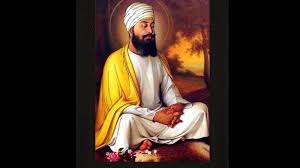Jaibans Singh

The 350th anniversary of the epic martyrdom of Guru Tegh Bahadur to challenge injustice by an arrogant and repressive regime is being commemorated the world over with great reverence. The thoughts of the Guru are an ocean of knowledge, philosophy and spirituality that a normal human being (especially this author) cannot assimilate in totality. However, this is the right time to reflect upon the life and teachings of the great Guru, imbibe the spirit of his message and try to follow the path shown by him with utmost humility.
Dedication to Parents and to Faith
The first lesson that can be drawn from the Guru’s life pertains to his dedication to his parents and to his faith. Despite being spiritually inclined he learnt military skills as desired by his Guru and father, Guru Hargobind. He fought in his Guru’s army with such valour that his name was changed from Tyag Mal to Tegh Bahadur by the latter. Later, when his Guru, decided to pass the Gur Gaddi (seat of the Guru) to his grandson, he did not utter even one word of dissent and went to reside in Bakala as ordered. Any person in the modern world who can show even a fraction of such obedience, faith and perseverance would lead the most enlightened life.
Spiritual Detachment and Mental Resilience
The second big lesson of spiritual detachment and mental resilience, comes from the time when he was named by Guru Har Krishan as successor to the Gur Gaddi. Guru Har Krishan had said the words “Baba Bakala.” Many Baba’s, including members of the Guru Parivaar (family), set up camp in Bakala to stake claim on the Gur Gaddi. All through this turmoil, Guru Tegh Bahadur remained detached and immersed in meditation. He was revealed as Guru by the trader Makhan Shah Labana, on the basis of a test and then compelled by the Sikhs to take his divine place. His Bani (holy word) in the Guru Granth Sahib teaches detachment from ego, wealth, and transient pleasures. He says, “Saadho Man Kaa Maan Tiaagao; Kaam Krodh Sangat Durjann Kee, Taa Te Ahinis Bhaagao.” (O Saints, renounce the ego and always flee from lust, wrath, and evil company). In the modern world too, mental health practices can help cope with stress and material pressure in a manner that paves the way for an enlightened existence.
Messiah of Peace and Goodwill
Guru Tegh Bahadur rooted for peace and stayed away from conflict when he could. This is aptly exemplified from his reaction on being denied entry into the sacred Sri Harmandir Sahib by the Minas sect then led by Harji, the grandson of Baba Prithi Chand. Despite insistence of his Sikhs to force an entry he chose to remain calm and paid obeisance at a place away from the Gurdwara but within the precincts that later got to be known as Thara Sahib (Pillar of patience).

Indifference to Misery and Happiness
When the time came to make the supreme sacrifice, Guru Tegh Bahadur showed no fear and remained true to his duty. His teachings guide mankind towards indifference to both misery and happiness. His Bani prepares the seeker to walk through life with dignity and compassion. He writes in his Bani, “Jo Nar Dhukh Mai Dhukh Nehee Maanai, Sukh Sanaehu Ar Bhai Nehee Jaa Kai, Kanchan Maattee Maanai” (That man, who in the midst of pain, does not feel pain, who is not affected by pleasure, affection or fear, and who looks alike upon gold and dust). The Guru further attempted to guide humanity towards the realisation that the world is illusionary, transitory and perishable in nature and such a truth dawns upon a person only through meditation. These are important lessons for the modern age.
Compassion and Care for Humanity
The Guru toured extensively and especially attempted to cover the routes followed by Guru Nanak during his Udasis. He went from Punjab to modern day Patna, Assam and Bangladesh, stopping at many places en-route. During these tours he spread the message of Guru Nanak and also exhibited great compassion and care for humanity. It is recorded that wherever he went, he tried to understand the pain of the people and helped ameliorate it. He distributed Langar (free community kitchen) for the needy in accordance with Sikh tradition, built Dharamshalas & resting places, provided relief to drought prone areas by creating sources of water, made Pathshalas (schools) for the poor and the needy and even gave direct aid to impoverished people by paying off their debts and treating the sick. The world survives on empathy, not dominance is the lesson that the modern world needs to learn from his social practices.
Lessons Derived from the Guru’s Martyrdom
His martyrdom teaches many lessons like the need to defend human rights and freedom of conscience, exhibiting moral courage against oppression and speaking the truth. He adopted a leadership model based on personal example and self-sacrifice. His followers were eager to die with him since he had taught them in his Bani, “Bhai Kahu Ko Det Naahi, Naa Bhai Manat Aan; Kaho Nanak Sun Re Mana, Gyaani Taahe Bikhaan.” (A person who causes fear to no one and who fears no one is spiritually wise).
Conclusion
Guru Tegh Bahadur gave his life defending another community’s right to practice its faith while upholding freedom of religion, thought, and expression. The Guru was firm in his belief that a person should remain ready to give up his head, but not forsake justice or those whom he or she has undertaken to protect. He considered the sacrifice of a life as insignificant against the need to maintain faith.
The Guru is remembered for his simplicity, piety and more so for his strong will that changed the course of history. The world needs to emulate his thoughts and ideas to resist all sorts of tyranny that is unleashed by evil forces.